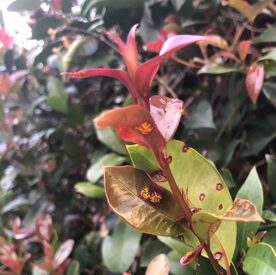Report myrtle rust on iNaturalist this summer
The organisation "Beyond Myrtle Rust" is asking the tramping and walking community to keep an eye out for the plant disease myrtle rust this summer. The fungus that causes myrtle rust infects exotic and native plants from the myrtle family, including pōhutukawa, rātā, ramarama and mānuka. You could see it in your neighbourhood, or when you are out in the bush. You can learn more about the disease on the Beyond Myrtle Rust FAQ page.If you find myrtle rust while out and about, please report the find on iNaturalist.
How to spot it
Myrtle rust looks like pustules of rust-coloured pollen. The disease is most commonly found on new growth, including young leaves, stems, buds and flowers. When the infected growth starts to die, the bright colour of the pustules fades. Once the new growth dies, the plant can look singed around the edges.
Other plant diseases can look a little like myrtle rust, so the best indicators are 1) the yellow pustules and 2) the host plant. Myrtle rust only infects plants from the Myrtaceae family. For more information on native and exotic myrtles found in New Zealand, check out the NZ Myrtaceae Key.
How to report myrtle rust
To report a suspected case of myrtle rust, you can download the iNaturalist app onto your phone or make an account on a laptop or desktop. Then follow these steps:
- Take a photo of the plant – but don’t touch the diseased area!
- Upload photos of the infected plant into a new observation.
- In the “what did you see?” section, type in “myrtle rust”.
- Depending on your phone’s privacy settings, you may need to add the location manually. Otherwise, the location field should fill in automatically.
It is very helpful for researchers to know what you think the host plant is. If you’d like to make a guess, please add this to the “Notes” section.
What happens next
Researchers in the myrtle rust community will help confirm the record and the host plant. This will then be compiled on the iNaturalist platform to give researchers, land managers and the public a clearer idea of where the disease is spreading. If your record is in a new area or on a new host, you may even see action by local government to confirm the sighting.
Happy tramping/walking and remember: keep your gear clean to protect our native plants.
Want to learn more?
You can read more about the arrival of myrtle rust and the research being done on this disease here.
If you’d like to learn more about myrtle rust research, you can follow Beyond Myrtle Rust on Facebook, Twitter @byondMyrtleRust and Instagram @beyond_myrtle_rust.
How to save someone's life
On a Club biking group trip recently a member had Sudden Cardiac Arrest. (Only 10% survive a SCA if not treated immediately!) Fortunately, another member in the group understood the importance and technique of performing CPR. (A defibrillator was available, but not functional!)
It would be very good if everyone who feels capable of assisting in such an emergency learns the very simple technique required, and you can learn how to do it by watching the video produced by St John's, by clicking here.
Info for people crossing farms - Mycoplasma Bovis
If you are tramping, cycling or horse trekking across a farm you need to be aware of Mycoplasma bovis. It does not pose any risk to you, but you can take some simple steps to stop it spreading.
An article that explains the issues is linked to here.
First aid reminders
Brett represented the club on an outdoor first aid course recently. He prepared a concise set of points to note when someone is injured, which you can see here.
